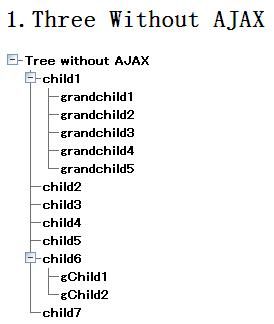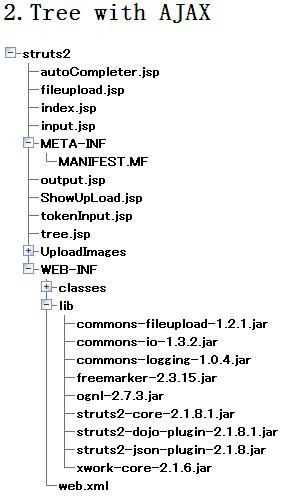stuts2中tree的实现
在struts2中,tree的实现主要是通过struts2-dojo-plugin-XXX.jar中的tree标签来实现的,首先在项目中引入此包,我使用的是sturts2.1.8.1。
在JSP中使用<%@ taglib prefix="sx" uri="/struts-dojo-tags" %>导入标签标签的同时,别忘了再HEAD标签中添加<sx:head/>,客户端JS文件的导入全指望它了!下面是实现tree的三种方式:
1.静态方式 也就是tree中的各个节点是在jsp文件中静态写入的,在运行之前就知道其结构,下面是一个Demo:
 JSP
JSP
<
h2
>
1.Three Without AJAX
</
h2
>
<
sx:tree
label
="Tree without AJAX"
id
="parentId"
templateCssPath
="/struts/tree.css"
showRootGrid
="true"
showGrid
="true"
>
<
sx:treenode
label
="child1"
id
="child1Id"
>
<
sx:treenode
label
="grandchild1"
id
="grandchild1Id"
/>
<
sx:treenode
label
="grandchild2"
id
="grandchild2Id"
/>
<
sx:treenode
label
="grandchild3"
id
="grandchild3Id"
/>
<
sx:treenode
label
="grandchild4"
id
="grandchild4Id"
/>
<
sx:treenode
label
="grandchild5"
id
="grandchild5Id"
/>
</
sx:treenode
>
<
sx:treenode
label
="child2"
id
="child2Id"
/>
<
sx:treenode
label
="child3"
id
="child3Id"
/>
<
sx:treenode
label
="child4"
id
="child4Id"
/>
<
sx:treenode
label
="child5"
id
="child5Id"
/>
<
sx:treenode
label
="child6"
id
="child6Id"
>
<
sx:treenode
label
="gChild1"
id
="gChild1Id"
/>
<
sx:treenode
label
="gChild2"
id
="gChild2Id"
/>
</
sx:treenode
>
<
sx:treenode
label
="child7"
id
="child7Id"
/>
</
sx:tree
>

效果图如上所示。
2.半动态方式 下面的例子是根据服务器端的项目目录生成的节点树,在jsp中的表现代码上显得非常简捷:
首先要生成一个用于封装目录下文件结构的类:FileWrapper.Class
 FileWrapper.java
FileWrapper.java
package
tree;
import
java.io.File;
public
class
FileWrapper {
private
File file;
public
FileWrapper(String path){
file
=
new
File(path);
}
public
FileWrapper(File file){
this
.file
=
file;
}
public
String getId(){
return
"
file_
"
+
file.hashCode();
}
public
String getName(){
return
file.getName();
}
public
String getAbsolutePath(){
return
file.getAbsolutePath();
}
public
FileWrapper[] getChildren(){
File[] files
=
file.listFiles();
if
(files
!=
null
&&
files.length
>
0
){
int
length
=
files.length;
FileWrapper[] wrappers
=
new
FileWrapper[length];
for
(
int
i
=
0
;i
<
length;i
++
){
wrappers[i]
=
new
FileWrapper(files[i]);
}
return
wrappers;
}
else
{
return
new
FileWrapper[
0
];
}
}
}
新建一个Action,用于向ValueStack中添加生成目录树所需的一些数据,
 DynamicTreeAction.java
DynamicTreeAction.java
package
tree;
import
javax.servlet.http.HttpServletRequest;
import
org.apache.struts2.interceptor.ServletRequestAware;
import
com.opensymphony.xwork2.ActionSupport;
public
class
DynamicTreeAction
extends
ActionSupport
implements
ServletRequestAware {
private
static
final
long
serialVersionUID
=
-
8571025932301813496L
;
private
FileWrapper root;
private
HttpServletRequest request;
public
FileWrapper getRoot(){
return
root;
}
public
void
setServletRequest(HttpServletRequest request){
this
.request
=
request;
}
public
String execute(){
root
=
new
FileWrapper(request.getSession().getServletContext().getRealPath(
"
/
"
));
return
SUCCESS;
}
}
在xml中配置action
 struts.xml
struts.xml
<
package
name
="ajax"
namespace
="/ajax"
extends
="json-default"
>
<
action
name
="DynamicTree"
class
="tree.DynamicTreeAction"
>
<
result
>
/tree.jsp
</
result
>
</
action
>
</
package
>
JSP文件内容:
<
h2
>
2.Tree with AJAX
</
h2
>
<
sx:tree
id
="appFiles"
rootNode
="root"
nodeTitleProperty
="name"
nodeIdProperty
="id"
childCollectionProperty
="children"
/>
看起来非常简捷,其实struts已经帮我们干了好多事情,
OK,查看一下效果:

